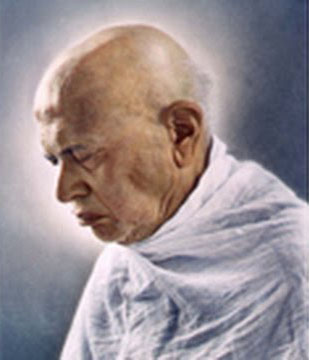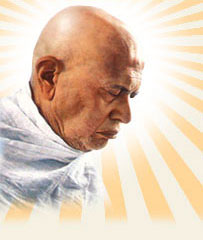Gurudev Shri Kanji Swami
 |
The Jain Samaj has been generally interpreted as an orthodox society, but it is not true. It has witnessed internal movements, a process of reforms and a strong undercurrent of sensible liberalism which have given it new directions time and again. Among these, the most successful twentieth century Jain movement has been spearheaded by Gurudev Shri Kanji Swami. Gurudev was instrumental in starting a new revolution in the percept and practice of Jainism, thereby putting thousands of souls on the true path of salvation.
Kanji Swami was born in Umrala, a small village in the Kathiawar region of Gujarat, in V. S. 1946 (1889 AD) to a Sthanakvaasi family. He showed a great ability for learning and was considered the most intelligent student of his class in the school. His mother died when he was 13 and he lost his father at the age of 17. After this, he started looking after his father's shop. He utilised the frequent periods of lull in the shop in reading various books on religion and spirituality. Turning down the proposals of marriage, he confided in his brother that he wanted to remain celibate and take up renunciation.
 |
Eventually he took renunciation as a Sthanakvaasi monk in 1914 at the hands of Shri Hirachandji Maharaj. During the ceremony, while riding on an elephant, he inauspiciously tore his robe, which was later to prove an ill omen in his monastic career. He embarked upon a rigorous study of the Shwetamber scriptures and finished a detailed study of the 45 Agams (Jain Scriptures) including a deep analysis of several hundred verses. Being a believer in purushaarth (self effort) for achieving emancipation, he quickly became a learned and famous monk and, backed by his seventeen renditions of the Bhagvati Sutra with its 100,000 verses, came to be known as the 'Kohinoor of Kathiawar.'
But all this time he could never completely engage with the scriptures he was studying and continued his search for the still evasive Truth. Then, around 1921, he came upon Acharya KundKund's Samaysaar - 'Essence of the Doctrine' - the study of which was like "drinking the nectar of Truth" for him. He followed on by studying the writings of other Digambers such as Acharyakalp Pandit Todermalji and Shrimad Rajchandra.
During his discourses he began to incorporate the ideas picked from these studies and began to lead a kind of double life, nominally a Sthanakvasi monk but referring to the Digamber literature.
His assertions that "vows, giving and fasting were ultimately worthless if performed without any understanding of the soul" did not endear him to the Sthanakvasi community. This lead to a great turmoil in his life and in the lives of his followers. He began experiencing distress about his own self and about his behaviour as a Sthanakvasi monk. This came to a head at the small town of Songadh on Mahavir Jayanti day in 1934, when he formally removed his Muhapatti (a small white cloth to cover the mouth), left the Sthanakvasi monk-hood and proclaimed himself to be a Digamber shravak.
Even though he had some devotees, the Sthanakvasi community was understandably enraged by this betrayal and even his life was threatened. Kanji Swami fled to Songadh where eventually the local community became reconciled to him and indeed virtually all of the nearly 300 families who today live at Songadh and follow him claim to be of Sthanakvasi background.
Gurudev Kanji Swami started discourses, many of which are recorded on tapes, in the form of running commentaries on Acharya KundKund's writings. He never wrote any books and did not claim to say anything new but merely reiterating the words of Arihantas, acharyas and other scholars apart from Bhagwan Mahavir Swami, KundKund Acharya and Pt. Todarmalji.
Gurudevshri's Discourses : Ignoring mundane topics such as dietary prescriptions, on the basis that all Jains would know about such matters, he directed his teachings to the subject of the soul and to Acharya KundKund's representation of it as the one eternal and unconditional entity. Kanji Swami's insistence on the primacy of the absolute level of truth over the relative one of ordinary life is obvious from his frequent comment: "Please try to understand. No soul, with or without knowledge, has the slightest ability to move even a particle. In such circumstances, how can it do anything to the human body, or to any other thing for that matter?"
For him Samyak darshan (right faith) was a prerequisite to any meaningful progress upon the spiritual path. "The real path lies in self-experience of the soul after securing itself in Samyak darshan". He was convinced that the three jewels of Samyak darshan, Samyak gyan and Samyak charitra (right faith, right knowledge and right conduct) could only function effectively on the basis of a prior experience of the soul, and considered the various rituals and merit-making practices as subordinate. In an interview in 1977 he denied being hostile to the traditional Jain monk-hood and regarded them as personifying the fundamental principles of Jainism. However, he also pointed out that taking up formal initiation and behavioural practices, like the abandonment of clothes (common for Digamber monks) and other possessions, could not make an individual a true monk unless he had abandoned internal possessions as well.
By now the following had grown quite large and the small house became inadequate so his devotees started a building project at Songadh in 1937, which culminated in the 'Digamber Jain Swadhyay Mandir'. In honour of his favourite scripture, one of his devotees, who was later to become the leader of his following, Bahenshri Champaben, installed the Samaysaar in the main temple and the words of Acharya KundKund's five main treatises have been engraved on its walls. A temple dedicated to Shrimandhar Swami was consecrated in 1941.
Kanji Swami travelled on pilgrimage throughout India where he gave discourses and consecrated many temples. In 1980 he visited Kenya and installed many images of Tirthankars at temples in various towns. He had a profound impact on one particular family in Mombasa, the Bhagwanji Kachra family, who have continued their support to-date and even in London take a very active role at the Digamber Jain Mandir in Harrow. After a very dynamic and undoubtedly a revolutionary life, Kanji Swami left for his heavenly abode in a state of Samadhi on 28th November 1980.
-----------------------------------------------------
Mail to : Ahimsa Foundation
www.jainsamaj.org
R030503